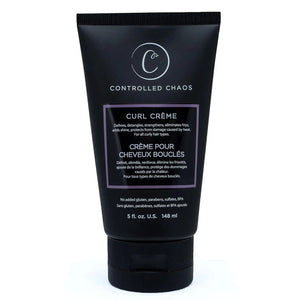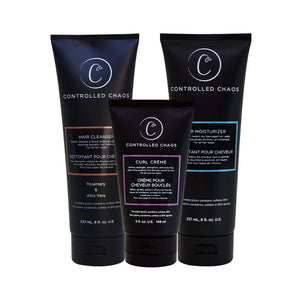

Curls can add a lot of personality and style to your look. However, sometimes, curls can be incredibly frustrating when they fall out shortly after styling. If you ask, "Why do my curls fall out so quickly?" you’re not alone. Let’s discuss the most common reasons behind this problem. Also, get some easy solutions to help you achieve long-lasting curls.
Reasons Your Curls Fall Out so Quickly
1. Hair Type and Texture

Fine or straight hair tends to have a more challenging time maintaining curls than thicker or naturally curly hair. Fine hair lacks the texture needed to grip the curl, causing it to fall out more quickly.
Solution: To add grip and volume, use a lightweight mousse or a texturizing spray before curling. These products can provide the hold that fine hair needs to keep curls intact.
2. Hair Health
Overly processed, dry, or brittle hair can struggle to maintain a curl due to its compromised structure.
Solution: Incorporate deep conditioning treatments and hair masks into your routine. This helps to restore moisture and health to your hair.
3. Improper Use of Heat Tools
How you use heat tools can significantly impact the longevity of your curls. Using the wrong temperature, not allowing curls to cool properly, and using tools unsuitable for your hair type can contribute to curls falling out immediately.
Solution: Use a curling iron or wand that is appropriate for your hair type. Fine hair generally requires a lower heat setting (around 300-350°F). On the other hand, thicker hair can handle higher temperatures (up to 450°F).
4. Product Overload or Misuse
Using too many or the wrong type of products can weigh your hair down, causing curls to lose their shape quickly. Heavy creams and oils, while great for moisturizing, can harm holding curls.
Solution: Opt for lightweight styling products designed for curl definition and hold. A mousse, light gel, or curl-enhancing spray can provide the necessary hold. Thus, this way curls falling out after curling do not happen.
5. Environmental Factors
Humidity and weather conditions can wreak havoc on styled curls. High humidity causes hair to absorb moisture from the air, leading to frizz and limp curls.
Solution: Use anti-humidity hair products to create a barrier against moisture. Finishing sprays with a firm hold can also help lock in your style. Consider carrying a small touch-up product, like a smoothing serum or spray. These will help to manage frizz throughout the day.
6. Wrong Technique
Your curling technique matters. How you section your hair, the direction you curl, and how long you hold the curl can all influence the result.
Solution: Use small sections of hair when curling, as larger sections are less likely to hold a curl. Thus, it does not let curls fall out quickly. Hold the curling iron in place for about 10-15 seconds, but not longer, to avoid damage.
Styling Tips for Long-Lasting Curls
Utilize Sectioning Techniques
Proper sectioning can make a big difference in how uniform and long-lasting your curls are.
Solution: Divide your hair into manageable sections before you start curling. This ensures that each section gets the attention it needs, resulting in more even curls. Smaller sections will generally hold a curl better than larger ones.
Curl in Alternate Directions
Curling all your hair in the same direction can cause curls to clump together and lose shape faster.
Solution: Alternate the direction of your curls—curl some sections towards your face and others away from your face. This creates a more natural, voluminous look.
The Right Hairspray
You should always choose the right one, which is crucial for maintaining your curls. This is the best way to keep curls from falling out.
Solution: Use a flexible-hold hairspray to set your curls without making them stiff. Consider a strong-hold hairspray for extra hold, but be careful not to apply too much. Look for hairsprays that offer humidity protection if you live in a humid climate.
Invest in a Quality Curling Tool
Cheap curling irons can produce uneven heat and damage your hair, leading to poor curl retention.
Solution: Invest in a high-quality curling iron or wand with adjustable temperature settings. Ceramic or tourmaline options are excellent as they distribute heat evenly and reduce frizz.
Lifestyle Considerations
Hydrate Your Hair
Hydrated hair holds styles better than dry, brittle hair.
Solution: Drink plenty of water and use hydrating hair products. Leave-in conditioners and moisturizing oils can help maintain your hair's health.
Diet and Nutrition
What you eat can affect your hair’s strength and ability to hold styles. People who claim that their curls falling out, should work on diet and nutrition.
Solution: Maintain a balanced diet rich in vitamins and minerals, especially those known to promote healthy hair. These include biotin, vitamins A, C, and E, and omega-3 fatty acids.
Conclusion
In short, the above blog has answered you "Why do my curls fall out so quickly?" Maintaining long-lasting curls involves understanding your hair’s unique needs, and using the right tools and products. By focusing on the health of your hair, and protecting your curls from environmental factors, you can enjoy beautifully curled hair that lasts throughout the day. Remember, patience and experimentation are key—find what works best for you and stick with it.
FAQs:
What is the curly hair scale?
The curly hair scale categorizes hair textures into four main types: Type 1 (straight), Type 2 (wavy), Type 3 (curly), and Type 4 (coily). Each type is further divided into subcategories (A, B, C) based on the tightness and definition of the curl pattern.
Are my curls 2B or 2C?
2B curls are wavy with a defined "S" shape and moderate frizz. On the other hand, 2C curls are thicker, more defined waves that often form loose spiral curls and are more prone to frizz. Examine the shape and texture of your curls to determine if they are more like 2B or 2C.
Do I have 2C or 3A curls?
2C curls are thick, well-defined waves that can form loose spirals and are prone to frizz, while 3A curls are larger, looser spirals that are springy and shiny. Compare the definition and tightness of your curls to distinguish between 2C and 3A.
What is a number 3 curly hair?
Number 3 curly hair, or Type 3, features curls that range from loose, well-defined spirals (3A) to tight corkscrews (3C). This type of hair tends to have a lot of volume and is prone to frizz and dryness.
How are curls graded on the hair curl scale?
Curls are graded on the hair curl scale based on their shape, tightness, and definition. The scale ranges from Type 1 (straight) to Type 4 (coily), with subcategories A, B, and C within each type, representing increasing curl tightness and density.
Can someone have multiple curl patterns on the hair curl scale?
Yes, it's common for individuals to have multiple curl patterns on the hair curl scale. Hair can vary in texture and curl pattern in different areas, such as having looser curls at the crown and tighter curls at the nape.



















